Ozoroa barbertonensis
Ozoroa barbertonensis Retief
Family: Anacardiaceae
Common names: Barberton ozoroa
Introduction
Ozoroa barbertonensis is different from the rest of the southern African species of Ozoroa, with its beautiful, much longer, narrow leaves with shiny upper surfaces and greyish green lower surfaces, and because the leaves are longer than the internodes and are crowded on the stems. Its small, shrubby habit with many stems growing from a woody rootstock also set it apart from the others, which are trees or large shrubs.
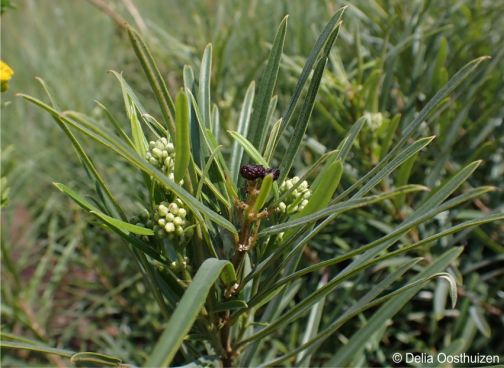
Description
Description
Ozoroa barbertonensis is a multi-stemmed, evergreen subshrub or shrub that grows 0.4-1.5 m high, with several erect stems growing from a woody rootstock. The stems are brown, hairy and have milky sap. The leaves are simple, with smooth margins, linear to narrowly oblong, 55-80 x 4-7 mm, alternate to almost whorled. The tip of the leaf is narrowly ovate with a visible external gland below the leaf. The vein is pinnately compounded with many lateral veins. The leaves of Ozoroa barbertonensis are covered with soft hairs when young and develop more definition of appearance with age. Both surfaces have hairy indumentum, however the hairs on upper surface are not as dense as those on the lower surface. The flowers are small, white, in axillary and terminal clusters, and it has been recorded to flower in late summer (from January to March ). Male and female flowers are on separate plants (dioecious). The fruit is a fleshy, rounded, wrinkled berry, up to 5 x 6.5 mm. The seed is pendulous from the basal funicle.
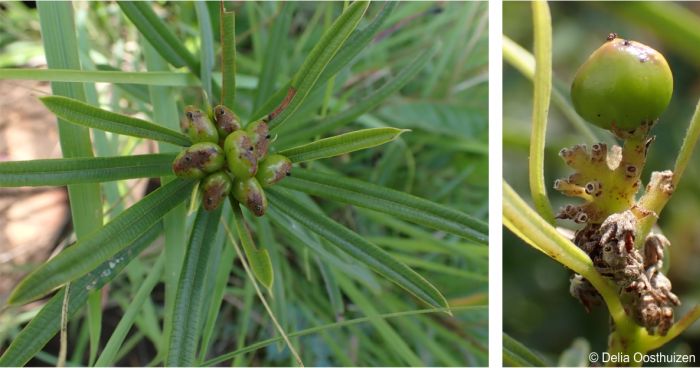
Conservation Status
Status
Ozoroa barbertonensis is currently assessed as Vulnerable (VU) in the Red list of South African Plants, meaning that the population is facing a high risk of extinction. This is because it has a very small natural range and grows in serpentine soils that are rich in minerals and there is a risk that these areas will be mined.
Distribution and habitat
Distribution description
Ozoroa barbertonensis is endemic to South Africa, it occurs in an area of less than 205 km² near Barberton in Mpumalanga province. It grows primarily in the subtropical biome, and is found in grassland on rocky hillsides where it grows in among the rocks, on white-green band of serpentine soils at 1 000 m altitude.
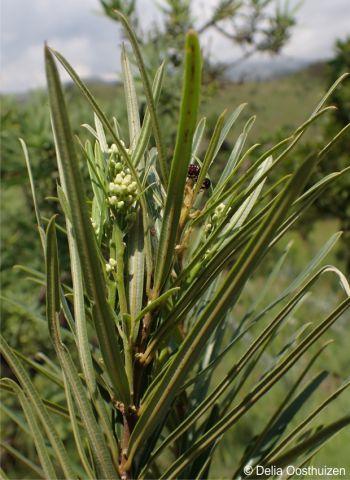
Derivation of name and historical aspects
History
Ozoroa barbertonensis belongs in the Anacardiaceae, commonly known as the mango or cashew family, with over 83 genera with about 860 known species. The origin of the name Ozoroa is not known. The species name barbertonensis is derived from its place of endemism, which is called Barberton in Mpumalanga, South Africa.
Ecology
Ecology
The shrub has a compact three-dimensional shape, which can be used as a filler, or for small hedges or screening in a garden. Because of its resilience it can also be grown in gardens with rocky, mineral-rich soils given that it grows in serpentine soils between the rocks.
There is currently no evidence that Ozoroa barbertonensis is being used medicinally. The other identified plants of the same genus that are used medicinally are mostly trees such as Ozoroa sphaerocarpa, Ozoroa reticulata and Ozoroa insignis which are used in traditional medicine to treat various diseases.
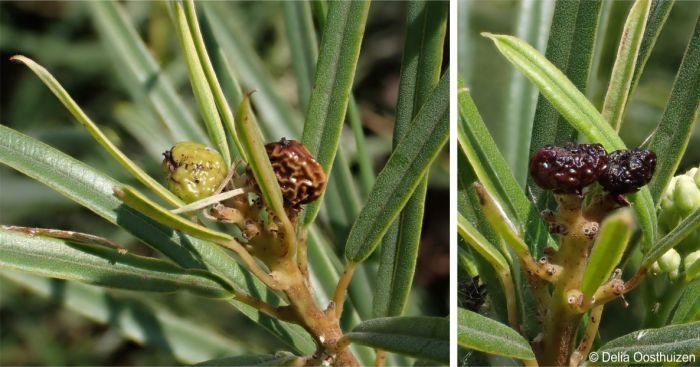
Growing Ozoroa barbertonensis
Grow
This plant grows in between the rocks, in serpentine soils that have low levels of nitrogen (N), phosphorus (P) and potassium (K). Ozoroa barbertonensis is one of the examples of plants that are tolerant of serpentine soils, which may make it easier to cultivate in gardens due to its resilience.
Ozoroa barbertonensis can be grown from seeds or cuttings. Fresh, good quality seeds can be sown in porous growing media with good drainage that is of good quality and free from diseases. Clean off the fleshy outer layer and sow the seeds in spring or early summer in a tray containing the well-drained soil, cover the seeds with vermiculite or sand to assist with germination and place where there is good light and air circulation. Keep the growing medium damp and start recording germination occurrence.
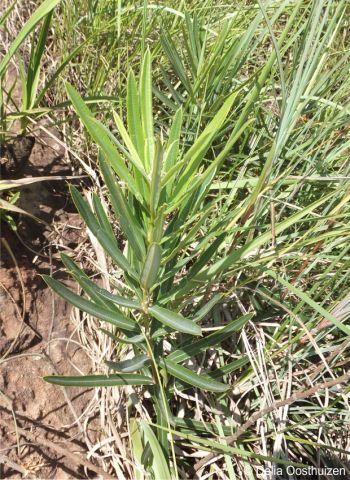
Remember to label your seeds with the following information: date, name of the seed, and name of the sower, so that the correct identity of your plantscan be guaranteed.
The horticultural principle for semi hardwood can be applied for cuttings. Cut a stem from a plant below the internode, about 10-15 cm long and remove the lower leaves. Place the cut end of the stem in a rooting hormone suitable for semi-hardwood cuttings and place in a well-prepared growing medium which can be a mixture of coarse sand and peat moss or a similar mixture.
The semi hardwood cuttings are propagated when the stems are not completely matured, at this point the wood is relatively firm but still flexible enough to bend.
When the plant is grown and well established in a garden, add a layer of mulch to keep the soil moist and reduce weeds. The plant requires good watering when young but once established, it can survive periods of drought and a fair amount of frost.
References
- Coulibaly, A., et al. 2019. GC-MS Analysis and antibacterial activities of Feretia apodanthera Del. (Rubiaceae) and Ozoroa insignis Del.(Anacardiaceae). Journal of Diseases and Medicinal plants 5(3):52-59.
- Gould, M. 1992. The buchus: cultivation and propagation. National Botanical Institute, Cape Town.
- Guney D., Bayraktar A., Atar F. & Turna I. 2021. The effects of different factors on propagation by hardwood cuttings of some coniferous ornamental plants, Turkey. Šumarski list 9–10: 467–477.
- Moffet, R.O. 1999. A new species of Rhus (Anacardiaceae) endemic to serpentine near Barberton, Mpumalanga (Eastern Transvaal). Botanical Journal of the Linnean Society 130: 37–42.
- Papo, L.A., Van Vuuren, S.F. & Moteetee, A.N. 2022. The ethnobotany and antimicrobial activity of selected medicinal plants from Ga-Mashashane, Limpopo Province, South Africa. South African Journal of Botany 149:196-210.
- Retief, E. 1990. A new species of Ozoroa from the Transvaal. Bothalia 20(2):219-221.
- Van der Merwe, J.P., et al. 2023. Predicting temperature and rainfall for plantation forestry in Mpumalanga, South Africa, using locally developed climate models. Agricultural and Forestry Meteorology 329: 109275.
- Victor, J.E., Retief, E. & Van Wyk, A.E. 2009. Ozoroa barbertonensis Retief. National Assessment: Red List of South African Plants version 2020.1. Accessed on 2023/08/15.
- Williamson, S.D. & Balkwill K. 2006. Factors determining levels of threat to serpentine endemics. South African Journal of Botany 72 (4):619-626.
- Williamson, S.D. 2016. Endeminism diversity and priorities for the conservation of serpentine areas in the Barberton Greenstone Belt, Mpumalanga, South Africa. PhD thesis, University of the Witwatersrand, Faculty of Science, Johannesburg.
Credits
Sefularo Ramaboea
National Zoological Garden
August 2023
Acknowledgements: the author appreciates the help of Delia Oosthuizen for providing the images.
Plant Attributes:
Plant Type: Shrub
SA Distribution: Mpumalanga
Soil type: Loam, Metal-rich
Flowering season: Late Summer
PH:
Flower colour: White
Aspect: Full Sun
Gardening skill: Average
Special Features:
Horticultural zones








Rate this article
Article well written and informative
Rate this plant
Is this an interesting plant?
Login to add your Comment
Back to topNot registered yet? Click here to register.